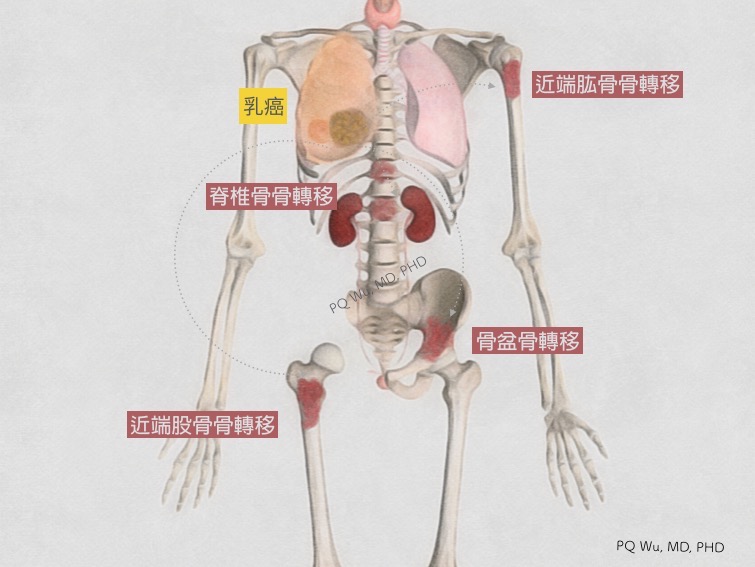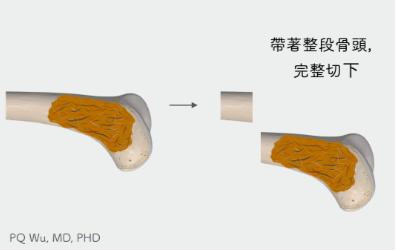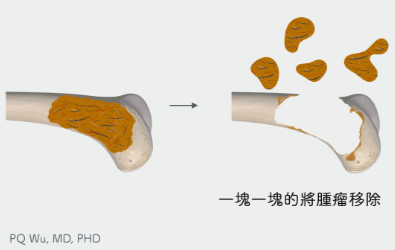Breast cancer is common cancer for women in Taiwan. It ranks first among all female cancers according to the top 10 cancer data in Taiwan released by the Taiwan CDD in 2015. Compared with Europe and the United States, the age distribution of breast cancer patients in Taiwan was younger, and the influence to patients was also greater. Breast cancer at the primary occurring place often incurs metastasis to distant organs such as bones, lungs, liver, and brain, even if it was well controlled by medication and surgery.
by PQ Wu

In the 1980s, the autopsy of breast cancer patients found that up to 73% of patients had bone metastasis, and today 6-8% of bone metastasis was found via chest pelvic computer tomography (CT-TAP) or database analysis (*,**). Although the chance of bone metastasis of breast cancer is slightly lower than that of lung cancer, it is still common clinically because of the high incidence and the longer overall survival rate (high prevalence) of breast cancer. In addition, it is very annoying that bone metastasis of breast cancer can occur quite a long time after the breast cancer has been diagnosed. Under the condition of good control in the original disease, it is still possible to have bone metastasis after seven or eight years.
* Role of bone scan in addition to CT in patients with breast cancer selected for systemic staging. Br J Surg 2016; 103: 839–44.
** Incidence of bone metastases in breast cancer patients in the United Kingdom: Results of a multi-database linkage study using the general practice research database. Cancer Epidemiology 2013; 37: 240–6.
Under what conditions would a breast cancer patient incur bone metastasis? We can learn from the following studies:
(i) Cancer Treat Rev, 2001. A large-scale study of 6,000 breast cancer patients showed that the risk factors for bone metastasis include (*):
1. Invasion of breast cancer to local lymphatic tissue.
2. Larger volume of primary breast cancer.
3. Positive estrogen receptor expression in breast cancer cells.
(ii) Breast Cancer Res Treat, 2000. It was found that bone metastasis was likely to occur when (**):
1. The breast cancer is low-grade.
2. Breast cancer cells are less active, i.e. cell division is less obvious (S-fraction phase < 5%).
3. The combined lymphatic tissue invasion is greater than four. (Greater than 40% chance of bone metastasis in this case).
You may feel strange that why would breast cancer still metastasize to bone when the cells have low malignancy and less cell division. It is because when the cells are highly malignant and active, most of them would incur visceral metastasis with a poor effect. This may also explain why bone metastasis will occur in breast cancer patients even years after the primary tumor has been controlled.
(iii) Cancer, 1997. It was indicated that for recurrent breast cancer patients, there would be 60% to 80% combined bone metastasis. (***)
(iv) Oncotarget, 2016. Tumor cells exhibit HR-/HER2-or HR-/HER2+. (****)
Therefore, for breast cancer patients who meet the above conditions, both physicians and patients should be more cautious to the possibility of bone metastasis.
* Prognostic factors for skeletal relapse in breast cancer. Cancer Treat Rev 27:153-157, 2001
** Metastatic breast cancer: clinical course, prognosis and therapy related to the first site or metastasis. Breast Cancer Res Treat 2000; 59.
***Skeletal complications of malignancy. Cancer 80:1588-1594, 1997
**** Patterns of distant metastasis in Chinese women according to breast cancer subtypes. Oncotarget 2016 Jun 16.
When bone metastasis ocurred in breast cancer patients, there is a 22% to 50% chance to incur skeletal-related events, SRE. Such events will bring considerable impact to these cancer patients (*,**). SRE refers to the occurrence to patients by bone metastasis.
1. Spinal cord compression. Bone metastasis of lung cancer and breast cancer is the most likely one to cause nerve compression in the spine.
2. Pathological fractures.
3. Reception of radiation to bone or bone surgery because of the presence of clinical symptoms, e.g., pain.
The tumor cells metastasized to the bone can produce pain by the induction of hormones such as bradykinin, interleukin-6 (IL-6), granulocyte-macrophage colony-stimulating factor, and tumor necrosis factor. The cells will also promote the growth of osteoclast and drive local bone destruction, resulting in subsequent severe pathological fractures. For detailed descriptions of this section, readers can click through the links below.
* Natural history of skeletal-related events in patients with breast, lung, or prostate cancer and metastases to bone: a 15-year study in two large US health systems. Support Care Cancer 2013; 21: 3279–86.
** Natural history of skeletal-related events in patients with breast, lung, or prostate cancer and metastases to bone: a 15-year study in two large US health systems. Support Care Cancer 2013; 21: 3279–86.
Clinically, if bone metastasis is discovered in breast cancer, the subsequent radiation, surgery, or both will be determined based on the location of the tumor, the internal medical situation, and the prognosis to improve limb pains and avoid pathological fractures. However, since we know that cancer patients have weaker physical strength and overall body condition than the general public, the indications requiring surgery are different. So, when will surgery be required? Please read the article below for a detailed description.
The surgery for breast cancer combined with bone metastasis can be divided into two methods according to the purpose:
Thorough cure (wide resection of tumor)
If it is a solitary bone metastasis or is for a patient with a good prognosis, we will treat it as a primary bone tumor and conduct wide resection, and hope to cure it thoroughly.
Reduce pain (intralesional curettage)
Suppose the bone metastasis is transferred to multiple parts of the body or is expected to have a worse prognosis. In that case, we will perform intralesional curettage to ensure faster recovery and lower surgical risk.

Wide Resection .

Intralesional Curettage
First. For patients with solitary bone metastasis or a good prognosis, wide resection and limb reconstruction will be conducted as we treat the metastasis as a primary bone tumor and hope to cure it.
Second. In the case of bone metastasis to multiple parts of the body or patients who are expected to have a poor prognosis, intralesional curettage is used. In addition, depending on the surgical situation, adjuvant therapy will be considered to reduce tumor recurrence.
The bone cavity leftover from the tumor removal will be reconstructed with autograft, allograft, artificial bones, or artificial joints, hoping to alleviate patients’ pain and avoiding complications of pathological fractures.
(Figure 1) However, because intralesional curettage will have a fairly high tumor recurrence rate (local recurrence), post-surgical radiation therapy will generally be conducted. However, radiation therapy has certain risks, including wound infection, low blood production, and the influence on peripheral organs.
For a detailed description of the surgery, please read our article below:
The image below is the X-ray scans for a 75-year-old woman who had suffered years of breast cancer and incurred systemic bone metastasis combining pathological fractures in proximal femurs at both sides.

(Top left) Pathological fracture on the right proximal femur. (Top left 2) Treated with a semi-artificial hip joint. (Top right) 17 months later, pathological fracture occurred at the left proximal femur and was fixed with intramedullary rods.
Breast cancer combined with bone metastasis is a fairly common clinical problem. Both physicians, family members, and patients should be on high alert. For patients with high risk and bone symptoms, appropriate imaging examination should be given, and the risk of pathological fractures should be assessed. If it conforms to the indication of surgical treatment, intervention should be executed as early as possible to avoid subsequent complications. Medication or radiation therapy should be given to improve the quality of life if surgery is not required or feasible. In addition, special care should be taken on the home environment and patient activities to avoid falling that causing follow-up problems!



